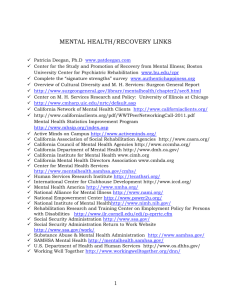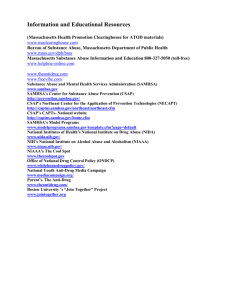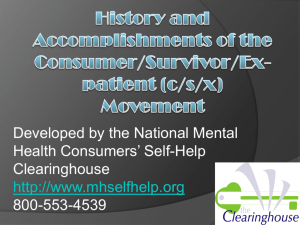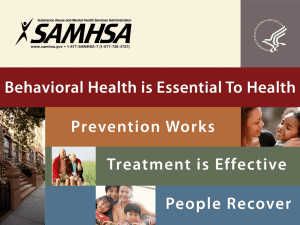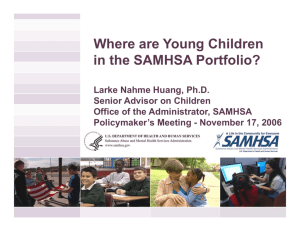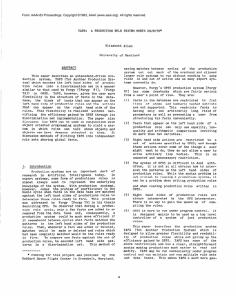Youth Recovery and Treatment Dynamics
advertisement
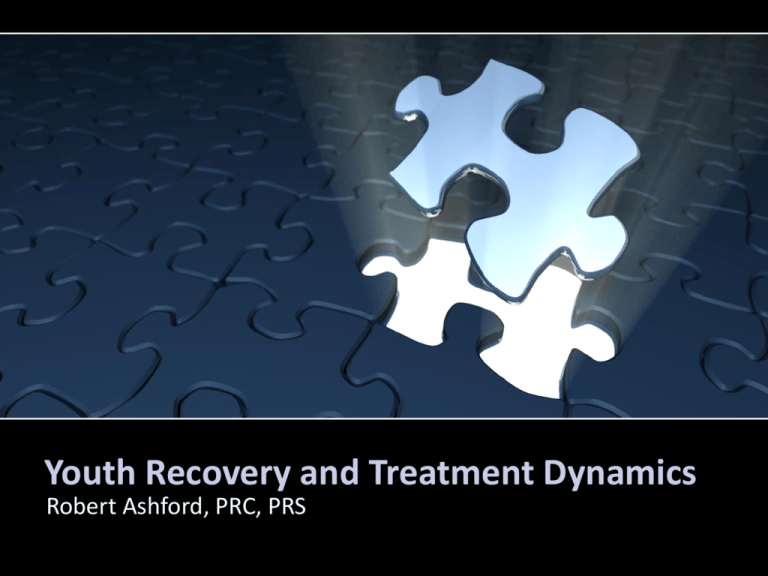
Youth Recovery and Treatment Dynamics Robert Ashford, PRC, PRS Youth Treatment and Recovery Dynamics D/FW TAAP Freedom Conference 2014 Goal 1 Characteristics of Young Adult Populations Most common traits and characteristics of YAPs Goal 2 Timeline/Continuum of Care Ideal timeline for the continuing care of YAPs, beginning to end Goal 3 Treatment Dynamics Exploration of current treatment modalities and emerging trends in BH treatment for YAPs Goal 4 Aftercare / Recovery Protection Exploration of aftercare planning and recovery protection best practices Goal 5 Recovery Dynamics Sustaining and growth of long-term recovery Wrap-up / Q&A Questions? Concerns? Characteristics of Young Adult Populations Presenting trends amongst YAPs • Age Range – 17-29 years of age • 632,959 total admission to TX (2011, SAMHSA) • Alcohol Misuse Only – most common • • Alcohol misuse Primary w/ Secondary - 17.6% overall • • 43.9% 17-29 YOA (2011, SAMHSA) Stimulants misuse - 13.8% overall • • 28.3% 17-29 YOA (2011, SAMHSA) Opiates misuse (including Rx) – 25.2% overall • • 21.7% overall, 20.8% 17-29 YOA (2011, SAMHSA) 27% 17-29 YOA (2011, SAMHSA) Marijuana misuse - 18.1% overall • 44.9% 17-29 YOA (2011, SAMHSA) Social and Physical Identities Social Characteristics and Traits Social Dynamics of YAP’s DEMOGRAPHICS • • • • • • • • • • 66.9% Male 33.1% Female 60.9% White (NH) 20.0% Black (NH) 13.1% Hispanic Origin 6.0% Other • American Indian, Alaska Native, Asian/Pacific Islander 40.2% unemployed or underemployed 22.1% gainfully employed 37.7% not in labor force • 13.9% students • 74.2% high school graduates/GED or less • 25.8% varying degrees of higher education completed 31.1% co-occurring with mental health disorder PEER INFLUENCE – SOCIAL SUPPORTS • • Aggregate age of first use • 17.6 years of age Demographic reported that less than 2 of the following social supports were in place: • Family, peers, mentors, educators, coaches, professional services, digital social supports Continuum of Care – Lifelong Approach • • • Early Screening Collaboration Stigma Reduction • • • • Onset/intervention of young adult consumer Pre-treatment Recovery Support Services Outreach services • • • • Menu of appropriate treatment services Recovery Support Services Alternative services and therapies Prevention/Education for families • Ongoing recovery protection support coupled with growth and exploration Stages of the Continuum of Care Ideal action items for the continuing care of YAPs • • • • • • • • Identification, through various measures, of a clinically significant substance use disorder, or cooccurring disorder. Intervention – Outreach – Education Enters into treatment – Gender specific, age specific programming IOP or Residential Completion of TX Transitional Living Aftercare Support Community Involvement • • • Education – Employment • Recovery High Schools (ARS) • Collegiate Recovery Programs (TYR – ARHE) • Young People in Recovery (YPR) Professional Development • YPR • NAADAC Ongoing community involvement • RCOs/ROSC Treatment Service Gaps Exploration of current treatment modalities and emerging trends in BH treatment for YAPs • State Run facilities – Adult versus Young Adult Programs • • • Do these exist? Working knowledge would dictate there is differing programs for adolescents (12-17) but not differing programs for consumers 18+ 12 step intensive, little experiential, group intensive, lack of “engaging, value-driven treatment methods” Privately owned facilities • • Specific Young Adult Programs, including Collegiate Recovery tracks 12-step focus, experiential and multi-systemic therapy that relies on engaging methods – making treatment “fun” State versus Private Are state run facilities keeping up? State # of Programs Adult YAP Adolescent State # of programs Adult YAP Adolescent TX 72 69 1 16 TX 403 368 17 124 Miss. 43 40 0 5 Miss. 55 44 5 13 PA 30 30 3 7 PA 548 491 38 211 LA 56 52 2 8 LA 87 80 11 33 AZ 37 35 1 11 AZ 182 141 22 82 Private entities are leading the way in established young adult specific programming, but with a median of 41% of Young Adult Populations being consumers entering into treatment facilities and programs, the number of specific programming does not support them. Aftercare / Recovery Protection Exploration of aftercare planning and recovery protection best practices • • • • • • Housing Education Employment Community Supports Basic Life Skills Development and cultivation Informational Issues and Skills Recovery Protection Resources Time spent in priority categories to protect recovery longevity Information Skills 10% Life Skills 15% Housing/Educa tion/Employm ent 20% Recovery Support System (IE 12 Step) 15% Community Supports 30% Service 10% Based on support services priority, identified by students at the University of North Texas Collegiate Recovery Program. 1. Community Supports 2. Housing/Education/Employmen t 3. Life Skills – Recovery Support System 4. Information Skills - Service Recovery Dynamics Longevity and growth of recovery Transition • Period from onset > intervention • Occurs at any age in the continuum Stabilization – Early Recovery • Entrance into first level of care, TX services provided (includes detox) • Beginning of self awareness, self knowledge Early Recovery •Transition back into community where community supports and recovery Protection resources occur Long-term Recovery •Growth and exploration stage, supported by Recovery Protection Resources •Self-identification preferred, ideal transition occurs within 1 year of tX episode with sustained recovery What is recovery? “A process through which individuals improve their health and wellness, live a selfdirected life, and strive to reach their full potential” (SAMHSA, 2014) The continuum revisited Are we providing appropriate AND effective services across the board? Intervention Identifying early onset, and onset, of behavioral health disorders with YAPs Treatment Menu of treatment options that are clinically appropriate and effective Post-treatment Recovery Protection Resources Clinical Aftercare Food for thought… Questions? Concerns? Thoughts? •New research from NDRI (Dr. Laudet) shows 62% of students utilizing a collegiate recovery program says their recovery is most benefited by peer services… •Peer Recovery coaching for adolescents is happening in fragmented pockets around the country…why not everywhere? Peer to Peer Services Concerns? •Are we continually trying to quantify recovery and treatment (“outcomes”) rather than allowing the terms to become empowering items for consumers? Thoughts? Literature Review and References • • Substance Abuse and Mental Health Services Administration (2010-14) • Working Definition of Recovery. 2014. http://www.samhsa.gov/newsroom/advisori es/1112223420.aspx • N-SSATS. 2011. http://samhsa.gov/data/DASIS/2k11nssats/ NSSATS2011TOC.htm • TEDS. 2001-11. http://samhsa.gov/data/2k13/TEDS2011/TE DS2011NTOC.htm • NSDUH. 2012. http://samhsa.gov/data/NSDUH/2k12MH_F indingsandDetTables/2K12MHF/NSDUHmhfr 2012.htm • NSDUH – MRB. 2014. http://samhsa.gov/data/2k14/NSDUH2014 MRB/Index.aspx ROSC Resource Guide. 2010. http://partnersforrecovery.samhsa.gov/docs/rosc_ resource_guide_book.pdf • Gorski, Terence. 2001. Overview of the Recovery Process. http://www.tlctx.com/ar_pages/recovery_overvie w.htm • UNT CRP Core Data. 2014. • Center for Mental Health in Schools at UCLA. 2010. Youth Substance Use Interventions: Where do they Fit into a School’s Mission?. • NIDA. 2014. Principles of Adolescent SUD Treatment: A RB Guide. 14-7953. • NCBI. 2011. Advances in Adolescent Substance Abuse Treatment. 10.1007/s11920-011-0214-2 • NIH. 2014. New Substance Abuse Treatment Resources Focus on Teens. http://www.nih.gov/news/health/jan2014/nida23.htm Wrap-up – Question & Answer Questions? Concerns? Thoughts? •Creating treatment models within existing programs, state and private, to promote young adult recovery • Sustainable resources that protect recovery…do you have them in your community? Questions? Concerns? •What do you think? Thoughts? Thank You for joining us today. For more information on Collegiate Recovery Programs, Recovery High Schools, Young People in Recovery – please contact Robert at Robert.Ashford@unt.edu
